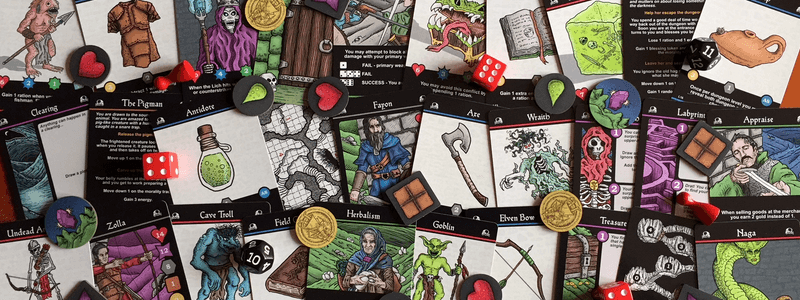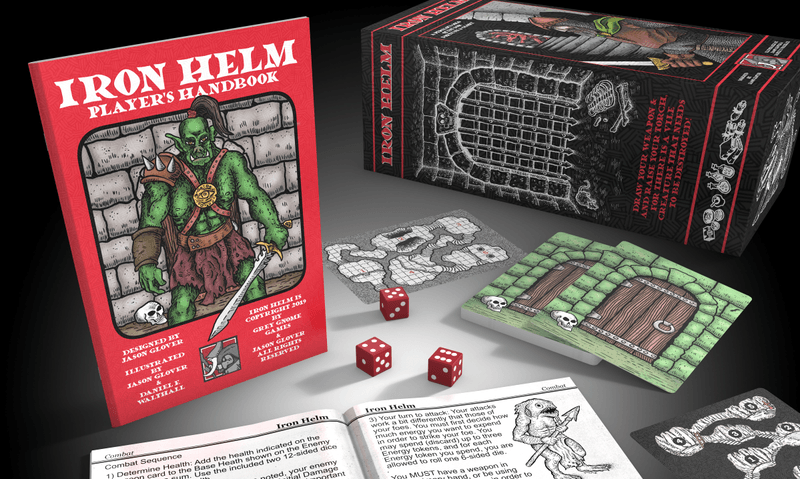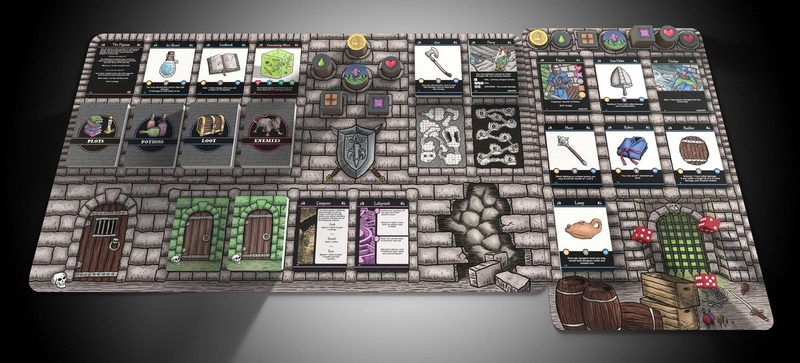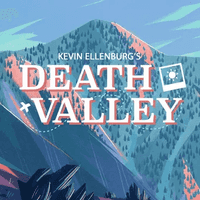I reviewed the Print and Play version available from PNP Arcade for $5.
Coming from a video game heavy background I've found dungeon crawling board games often have too much busy work making me less likely to get them out. Iron Helm on the other hand uses a small set of card decks where games often end at just the right length, making it one of my most played and favourite games.
Official Description
Iron Helm is a solo-play dungeon crawler in which you play as a hero in search of one last major score before finally hanging up the sword and retiring. Iron Helm uses a draw two, pick one mechanic, that has the player draw two cards from the dungeon deck, reveal one, and then decide to either resolve the revealed card, or take their chances with the unknown. Players will start the game with some coin that they can spend to equip themselves for the adventure. Once inside the dungeon they will encounter nasty foes, discover treasures, unlock plot cards, and ultimately face a dungeon boss. Along the way you will learn new skills and upgrade your character with new items. You will have to manage your health and energy levels, while trying to avoid hazards like getting poisoned or lost in the labyrinth.
Components
The print and play version mostly consists of making cards along with a few types of tokens to track attributes. Though you can print out the card trackers from Board Game Geek with your own cubes to track, I preferred this to making all the tokens (I still had to make blessing tokens as there is no alternative). I recommend printing out the player mat if you get this version to make it easier to track which weapons are equipped compared to those in your inventory. I didn't see a need in printing the gameplay mat. If you play this version you will need to have two d12 and at least three d6 dice, along with small euro cubes if you use the tracking cards.
The Game Crafter physical edition comes with all the base game cards, along with tokens and dice in a box with dividers and is large enough to fit some expansions. I think this version is expensive for what it is ($54.99 at time of review) especially compared to traditionally published games due to how The Game Crafter works. It is even more expensive if you live outside the USA due to taxes and shipping, so be careful as many people have mentioned how expensive the game is with all costs considered.
The Game Crafter also separately sells game and player mats to make laying out the game easier and more thematic. I don't think this is essential but I did like using a printed player mat in my printed version.
Gameplay
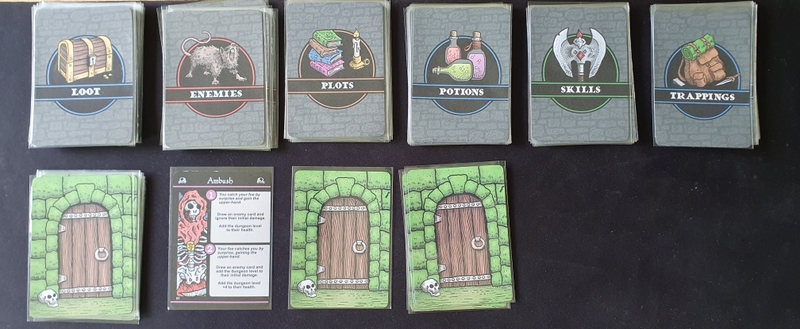 Start of dungeon exploration after setup
Start of dungeon exploration after setup
Iron Helm aims to give a dungeon crawler experience with character progression, narrative events, and random encounters in a relatively small package compared to larger dungeon crawl games.
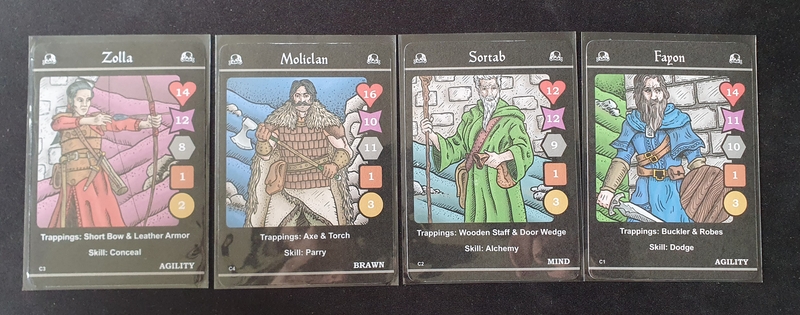 Available player characters in the base game
Available player characters in the base game
First you pick one of the four base game characters and start with the skills and trappings assigned to that character, along with tracking the starting health, energy, and rations listed on the character card. Each character plays differently as archetypal fantasy classes with the biggest impact being the main type of skills the character can upgrade with. Though any character can upgrade with any skill, just at a higher cost. This gives a good amount of variation; though some skills seemed more consistently useful compared to others that required rarer events to be useful.
![]() Tracking cards at the beginning of the game
Tracking cards at the beginning of the game
I used the printed tracking cards from BGG instead of using tokens as this felt cleaner and quicker to use. Most actions are going to involve tracking these character attributes, including gold, rations, poison, health, and energy (used to attack).
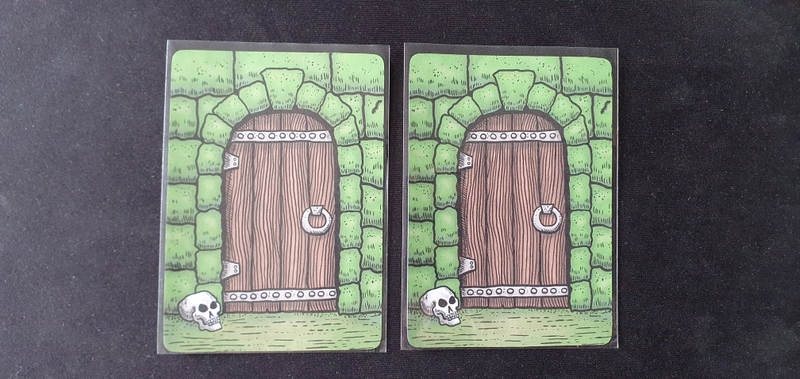 Two facedown dungeon cards two choose from
Two facedown dungeon cards two choose from
Next you start exploring the dungeon which consists of turns encountering the many surprises within the dungeon. At the first step of each turn you play two facedown dungeon cards from the top of the deck.
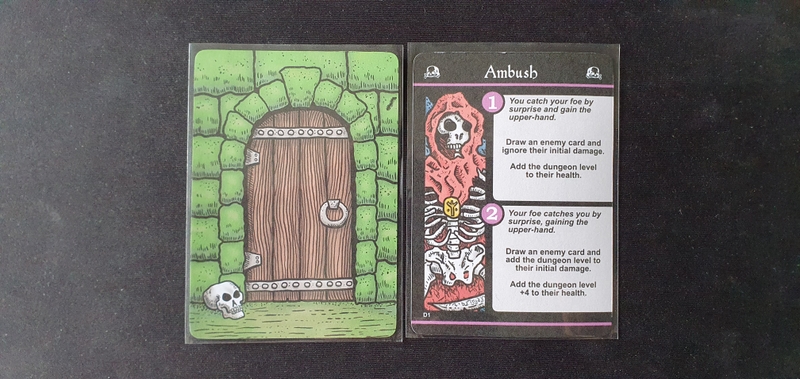 Flipping the first dungeon card
Flipping the first dungeon card
Then pick one and flip it face up, if you don't like the first card then you can push your luck and pick the other card. But you cannot go back to the first card if you choose to do this and have to take the second effect on the card.
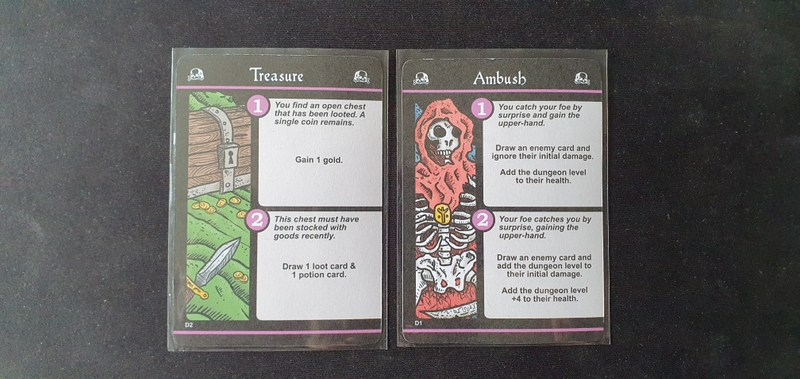 Flipping and selecting the second dungeon card option
Flipping and selecting the second dungeon card option
Dungeon cards will often have 2 effects, with the activated effect depending on which order the card was picked with the second effect being more impactful regardless of whether it provides a benefit or negative. Avoiding the first card you picked can be disastrous if you flip over a skirmish or poison trap as the second card. This gives great push your luck gameplay, where you might avoid a dangerous encounter to end up in a worse encounter on the other card. Though remembering which cards you have already discarded in the dungeon level can help judge if flipping over the second card is worth it.
The dungeon encounters can be enemies, merchants, campsites and many others with positive or negative impacts. This means you never know what will be behind the card. Certain skills and items can modify some of the encounters nullifying or reducing their negative impacts on you. If you encounter an enemy, then you start combat which must be completed before you can continue exploring the dungeon.
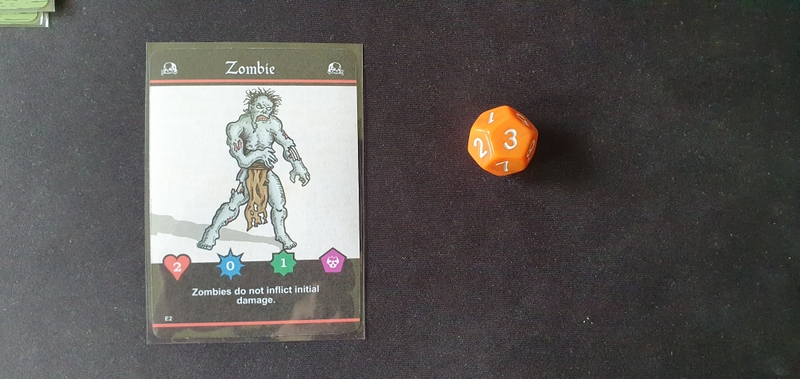 Combat with a two health zombie that has an extra health due to ambush card adding the dungeon level as health
Combat with a two health zombie that has an extra health due to ambush card adding the dungeon level as health
Enemy health scales based upon the dungeon level and whether it is a skirmish or ambush card, this does mean the game gets harder further into the dungeon. Though the damage is consistent which can mean you can take large amounts of damage early on especially with tougher enemies. Combat is dice based with your damage modified by equipment and skills. This leads into my main issue of the combat being too basic with equipment and skills only allowing for re-rolls or modifiers. Offensive potions can be used instead of using energy to attack or you can attack for one damage without spending energy. Thought I didn't find any of these combat options particularly compelling as it mostly felt like trying to trade blows with the enemy as quick as possible with limited strategy. Though as combat is only a part of the gameplay I didn't find it a deal breaker.
Each enemy also has an additional effect such as trading resources to avoid combat or other impacts if the enemy hits you. This gives extra flavour to the encounters and encourages being cautious with resources as they may be useful in other ways. Such as using rations to avoiding fighting wolves or giving gold to avoid fighting an ogre.
These encounter turns continue until you reach the end of the dungeon deck or reach ten plot points on your discarded plot cards. You then shuffle the dungeon deck, increase the dungeon level, lose a ration if available and increase your poison if high enough. This means you need to keep resources available as running out will be dangerous. The dungeon level impacts combat, making it more dangerous as you delve deeper, working great with the dungeon theming. Though you won't see any new content deeper in the dungeon, I do wish more of these small card based dungeon crawlers such as One Deck Dungeon would have additional encounters that only get added after each dungeon level.
 Example of a plot card that provides the chance to heal and gamble, while also providing two plot points
Example of a plot card that provides the chance to heal and gamble, while also providing two plot points
After completing the other parts of the dungeon level completion, you then draw a plot card from the plot deck. These plot cards give choices with many possible impacts. Each plot card has a point value, once you have discarded enough plot cards to sum ten or more points you then encounter the boss. The dungeon tracker card is used to track which level of the dungeon you are on. One issue I had as that the plot card values are inconsistent, so bad luck with the cards can make the game drag on. Making your chances of having enough health and energy to combat the boss less likely.
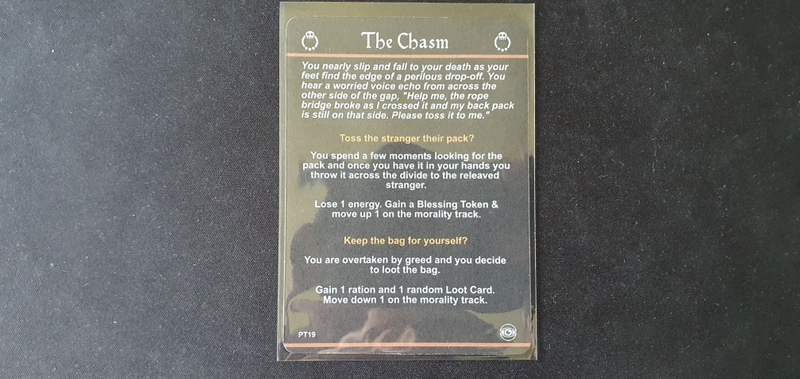 Example of a morality impacting plot card
Example of a morality impacting plot card
Some plot cards impact or use the player's morality to give different options or effects. This helps feel like you are actually roleplaying within this world, while being a small additional mechanic. Having high morality generally gives better long term impacts if you draw a plot card that uses your morality level, but choosing a morality lowering option often helps you keep alive. Though I did have many games where I had drawn a plot card that used morality before I had actually had a chance to lower or increase my morality, often making that plot card have little impact.
The morality issues listed are improved upon in the The Howling Abyss Dungeon Deck expansion which replaces the base game dungeon deck with additional complexity and better usage of morality.
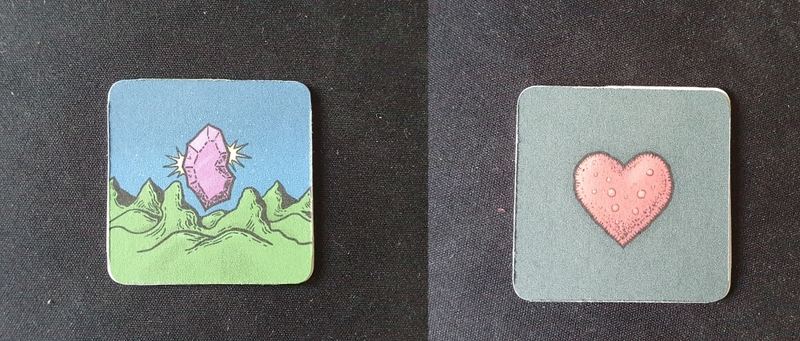 Example of a blessing token with a generic blessing side and an extra health on the other
Example of a blessing token with a generic blessing side and an extra health on the other
Blessing tokens can be gained during the dungeon and are placed with your player face down so that you do not know what is on the other side. During combat you can discard a blessing token to reroll a single combat roll. But if you keep tokens until you reach the boss, you can flip the tokens over and gain their effects. This can be healing, additional energy or removing poison. I found the healing from these very important, especially if I got unlucky with health potions draws from the potion deck after getting enemy encounter rewards or buying from the merchant.
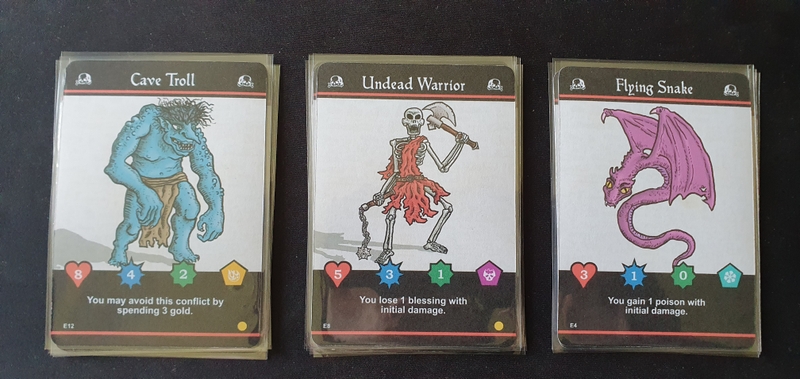 Stacks of each enemy type I killed during this dungeon
Stacks of each enemy type I killed during this dungeon
The boss is picked based upon the most common enemy type you fought during the dungeon. Bosses are just enemies with higher stats so combat is played as normal. Knowing which enemies you encountered during the dungeon can help you prepare weapons and items that gain benefits when fighting the expected boss enemy type. Such as potions that deal increased damage to undead enemies.
 Lich boss which was triggered due to the most defeated enemy type being undead
Lich boss which was triggered due to the most defeated enemy type being undead
I generally found the game quite hard with enemies and bosses able to inflict large amounts of damage in a single hit. With it being easy to run out of energy if you get too aggressive with attacks. So I would often get skills to could avoid skirmishes or risk choosing the second dungeon card as otherwise I would end up with low health by the time I got to the boss, with limited opportunities to heal up.
 Lich boss with low health and dealing 9 damage to the player
Lich boss with low health and dealing 9 damage to the player
The example above shows the end of a boss fight in a game I lost. Where the boss only had 2 health left but it made a counterstrike that dealt 9 damage (5 from dice difference added with 4 Lich base damage) which killed me. As there are no campaign/legacy systems without the adventure expansions, if you die nothing is carried over across games. So losing to unexpectedly very high damage right at the end can feel anticlimactic.
Game End
If you kill a boss you can end the game there and score based upon what you achieved, with thematic home flavour text given based on the score boundaries. There are expansions available that you play after completing a dungeon while keeping the same character as before allowing for campaign gameplay. As these are available via Print and Play, I was printing adventure expansions once I completed the game with the previous expansion.
I always like games with clear win/loss game ends, especially when you are building a character within a world. Having an additional score gives extra replayability by making a difference between games that you just managed to scrape a win compared to a win where everything thing went right for you.
Expansions
Iron helm has many small expansions of which I've each reviewed below. I would recommend trying the base game first then slowly building a collection of the expansions if going the printed route, though playing with all expansions at once does cause some bloat in mechanics and things to track.
Loot and Lore
 New cards in the Loot and Lore pack
New cards in the Loot and Lore pack
The Loot and Lore pack adds new characters, plot cards, enemies and items. This is combined with a base game to expand its content. I found this really improved the variety as it is always applied to the base game. I would heavily recommend getting this expansion once you have played and enjoyed your first few games of Iron Helm.
Adventure Expansions
Additional adventure expansions are also available to add campaign gameplay. These adventures are brought into the game after completing the base game and previous adventure expansions. Each adventure has a new boss, enemies, character and items. These help give more variety and seemed to have a slightly higher difficulty, though I do wish there was more to the experience between dungeons during a campaign. As you only reset attributes and have the opportunity to buy trappings. I would have liked more events to help build the narrative as you only get a small sentence of flavour text when starting the next dungeon. These expansions works well in print and play as you can just buy and print them after completing a previous dungeon.
Iron Chest Expansion
There is also the Iron Chest expansion which combines multiple features into a larger expansion set. This adds a new adventure pack, affliction and environment mechanics, artifact items and mercenaries. Each expansion can be applied to the game on their own or combined to make a much more complex experience.
The adventure pack is the only level 4 adventure and acts as the final dungeon of the adventure. This is just a slightly more difficult adventure pack with nothing significantly different from the other adventure packs.
Afflictions are gained during the dungeon and apply mostly negative impacts against your character, though they can be removed by using health potions and antidotes. These do make the game harder but add extra flavour and consequences for your actions. I found this an interesting mechanic adding danger to gaining poison on when fighting certain enemies.
Additional mini-boss enemies are added to the plot and enemy decks with benefits such as additional plot points and blessings for defeating them. These do increase difficulty but add additional tension when drawing cards from their decks.
Environments are drawn at the start of each dungeon level and add various changes to the dungeon encounter cards with positive and negative impacts. These help give variety to each dungeon level as the base game doesn't do much to differentiate between each subsequent level in the dungeon outside of higher enemy health. These do make the game slightly harder but you can take advantage of the positive benefits the environment might give, such as extra gold or rations. While thematically the design of these environments can clash with the theming of the adventure pack, I found this a good addition to the game but you do have to pay more attention to how the environment impacts your current action due to the lack of formatting on the environment card for its impacts.
Mercenaries can be hired for a few gold and each have different benefits for bringing them along on your adventure. But each time a mercenary's specific event happens they lose morale, represented by a d6 die placed on the mercenary card. If they reach zero morale the mercenary is discarded, but you can pay one gold to increase their morale by one. So conserving gold can be helpful when bringing them along. This mostly makes the game easier but not significantly as their benefits are often only helpful in certain dungeons and scenarios.
Artifacts are powerful items that can only be gained by discarding blessing tokens you have earned during a dungeon. These can make more complex character builds compared to the base and adventure pack items but the random drawing from the deck does mean you may get an artifact that doesn't work well with your planned build.
Random encounters in between each dungeon level are added by new encounter cards with two for each dungeon difficulty. These encounters can be positive or negative but you will have some idea of what will be ahead unless the encounter uses a dice roll. These help add to the theming and flavour of exploring a dungeon which I felt lacking in the base game.
Overall this expansion is fairly essential when you start wanting additional variety and greater difficulty. This difficulty is mostly fairly done and doesn't feel cheap. My only complaint with this expansion is when printing and playing the random encounter cards are not poker sized like the normal cards so may not fit in your current storage solution. I printed them at 65% scale to fit them in my deck boxes with the rest of the game's cards, they are still legible but do look off compared to the rest of the game's art.
Howling Abyss Dungeon Deck
 New cards in the Howling Abyss Dungeon Deck
New cards in the Howling Abyss Dungeon Deck
After initially writing this review the The Howling Abyss Dungeon Deck expansion became available for print and play. This expansion adds a new 18 card deck as an alternative to the base game's dungeon deck. This deck mostly contains the same ideas and encounters from that original deck but with additional complexity and impacts, which I felt were different enough to be interesting. Greater use of dice rolls and additional choices on the cards enhanced the push your luck as cards with negative impacts can have the chance to be even more dangerous. Some negative cards also have small positive impacts such as discarding rations but also gaining a potion. This means there are fewer moments where a playthrough can feel over due to a single dungeon card. The art on these cards are also more complex than the base game's art while keeping the original theme.
My favourite addition in this expansion are the new dungeon cards with completely new mechanics, these are mostly focused on the use of the character's morality. This gives the morality system a much needed improvement as it has limited use in the base game outside of scoring and a few specific cards. Having low morality when using this deck is now much more risky due to the Archangel card which makes you gain or lose health depending on morality.
I recommend this expansion once you've gotten too used to base game's dungeon deck, though I do wish most of the card changes would be applied to the original deck in a new edition of the base game.
